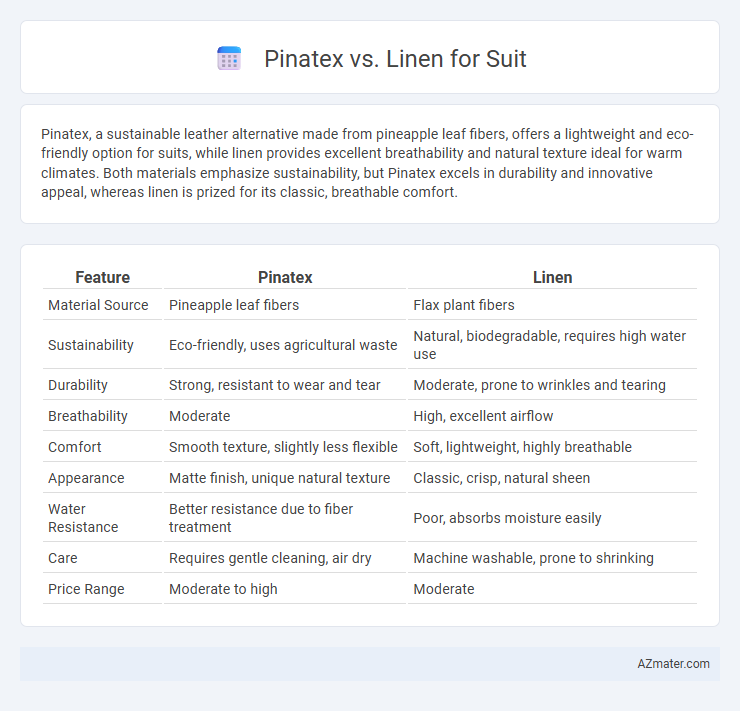Pinatex, a sustainable leather alternative made from pineapple leaf fibers, offers a lightweight and eco-friendly option for suits, while linen provides excellent breathability and natural texture ideal for warm climates. Both materials emphasize sustainability, but Pinatex excels in durability and innovative appeal, whereas linen is prized for its classic, breathable comfort.
Table of Comparison
| Feature | Pinatex | Linen |
|---|---|---|
| Material Source | Pineapple leaf fibers | Flax plant fibers |
| Sustainability | Eco-friendly, uses agricultural waste | Natural, biodegradable, requires high water use |
| Durability | Strong, resistant to wear and tear | Moderate, prone to wrinkles and tearing |
| Breathability | Moderate | High, excellent airflow |
| Comfort | Smooth texture, slightly less flexible | Soft, lightweight, highly breathable |
| Appearance | Matte finish, unique natural texture | Classic, crisp, natural sheen |
| Water Resistance | Better resistance due to fiber treatment | Poor, absorbs moisture easily |
| Care | Requires gentle cleaning, air dry | Machine washable, prone to shrinking |
| Price Range | Moderate to high | Moderate |
Introduction to Piñatex and Linen Suits
Pinatex, an innovative sustainable fabric made from pineapple leaf fibers, offers a lightweight and breathable alternative ideal for eco-conscious suiting. Linen, a classic natural textile derived from flax plants, is prized for its exceptional moisture-wicking and cooling properties, making it a popular choice for warm-weather suits. Both materials provide unique textures and sustainability benefits, with Pinatex presenting a vegan option and linen offering time-tested durability and breathability.
Origins and Material Composition
Pinatex is crafted from pineapple leaf fibers, a sustainable byproduct abundant in the Philippines, offering an eco-friendly alternative to traditional textiles. Linen, derived from the flax plant primarily cultivated in Europe, is valued for its natural breathability and durability in high-quality suits. Both materials reflect unique agricultural origins, with Pinatex emphasizing renewable waste utilization and linen highlighting natural flax fiber strength.
Sustainability and Environmental Impact
Pinatex, made from pineapple leaf fibers, offers a biodegradable and renewable alternative to traditional textiles, significantly reducing agricultural waste and water consumption compared to linen, which relies heavily on water-intensive flax farming. Linen production typically involves extensive pesticide use and land resources, whereas Pinatex utilizes byproducts otherwise discarded, promoting a circular economy in fashion. Both materials provide eco-friendly suit options, but Pinatex's innovative use of agricultural waste positions it as a more sustainable choice in reducing environmental impact.
Comfort and Breathability
Pinatex offers a sustainable alternative to traditional fabrics with moderate breathability, utilizing pineapple leaf fibers that provide natural moisture-wicking properties, but it tends to be stiffer compared to linen. Linen, derived from flax plants, is renowned for its exceptional breathability and lightweight comfort, making it ideal for suits in warm climates due to its ability to allow air flow and reduce perspiration. While Pinatex suits deliver durability with eco-conscious appeal, linen remains superior in comfort and ventilation, emphasizing its timeless role in breathable suiting fabrics.
Durability and Longevity
Pinatex, made from pineapple leaf fibers, offers impressive durability with natural resistance to wear and tear, making it suitable for sustainable suits that withstand regular use. Linen, derived from flax plants, boasts exceptional breathability and strength but tends to wrinkle easily, requiring more care to maintain its longevity. Both materials provide eco-friendly alternatives, yet Pinatex generally offers enhanced durability for long-lasting suit construction compared to traditional linen.
Style and Aesthetic Differences
Pinatex suits offer a unique, sustainable aesthetic with a textured, matte finish derived from pineapple leaf fibers, creating a modern, eco-friendly look that appeals to avant-garde fashion enthusiasts. Linen suits, characterized by their lightweight, breathable fabric and natural weave, exude a classic, timeless elegance with a slightly crisp, relaxed drape ideal for warm-weather formalwear. The distinct material origins cause Pinatex to have a more structured, innovative appearance, while linen provides softness and traditional charm in suit tailoring.
Suitability for Formal and Casual Occasions
Pinatex, derived from pineapple leaf fibers, offers a sustainable and textured alternative to traditional suit fabrics, making it suitable for casual and semi-formal occasions but less ideal for formal events due to its unique finish and matte appearance. Linen, known for its breathability and natural luster, excels in casual and summer formal suits, providing a lightweight and elegant option that may wrinkle easily under prolonged wear. Both materials cater to eco-conscious fashion but differ in formality and maintenance, with linen favored for classic tailoring and Pinatex appealing to innovative, eco-friendly styles.
Maintenance and Care Requirements
Pinatex suits require minimal maintenance, needing occasional brushing and spot cleaning with a damp cloth to preserve their durability and texture. Linen suits demand frequent gentle washing or dry cleaning to prevent shrinkage and maintain fabric breathability, with careful ironing to avoid wrinkles. Both materials benefit from proper storage in a cool, dry place, but Pinatex excels in resisting moisture and staining compared to delicate linen fibers.
Cost and Accessibility
Pinatex suits offer a more affordable alternative to traditional linen suits, with prices generally lower due to the cost-effective production of pineapple leaf fibers compared to flax. Linen suits, while pricier, are widely accessible in many markets because of their long-established presence in the textile industry. The availability of Pinatex suits is growing but currently limited to niche sustainable fashion brands, affecting overall accessibility compared to the broader distribution of linen.
Final Verdict: Which Material is Better for Suits?
Pinatex offers a sustainable, cruelty-free alternative with a unique textured finish derived from pineapple leaf fibers, making it ideal for eco-conscious fashion. Linen provides superior breathability, natural moisture-wicking properties, and a classic lightweight feel ideal for warm climates and formal suits. For durability and eco-friendliness, Pinatex excels, but for comfort and timeless elegance, linen remains the preferred choice in suits.

Infographic: Piñatex vs Linen for Suit
 azmater.com
azmater.com